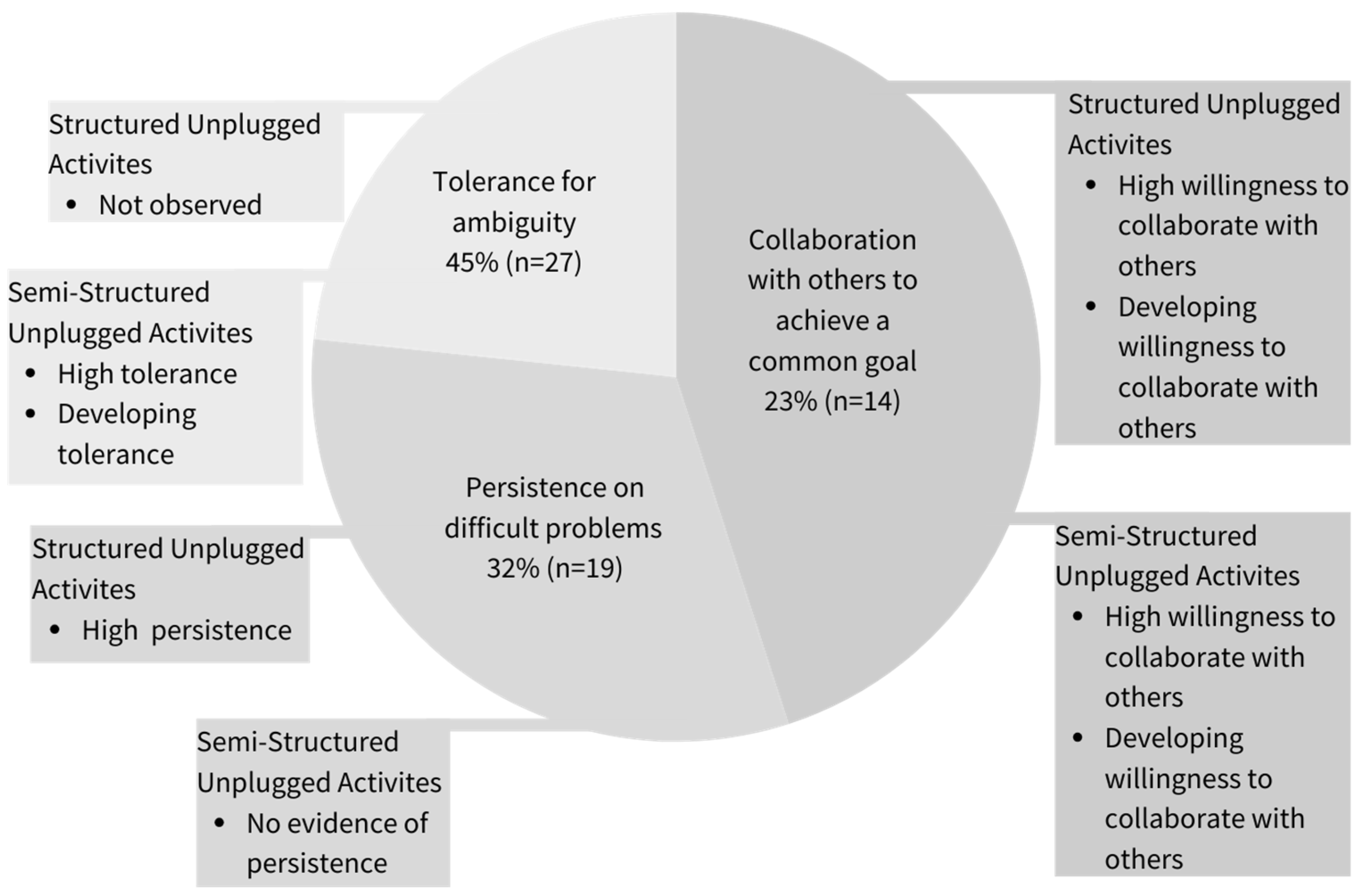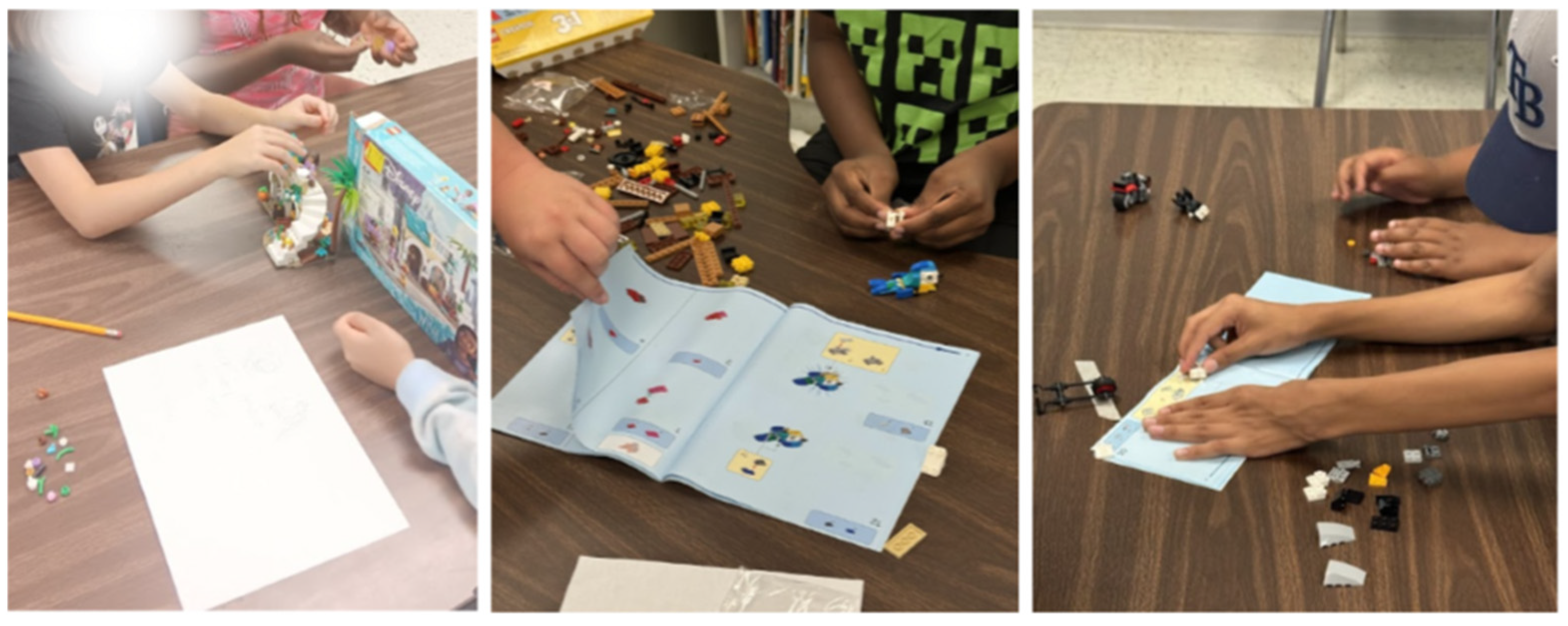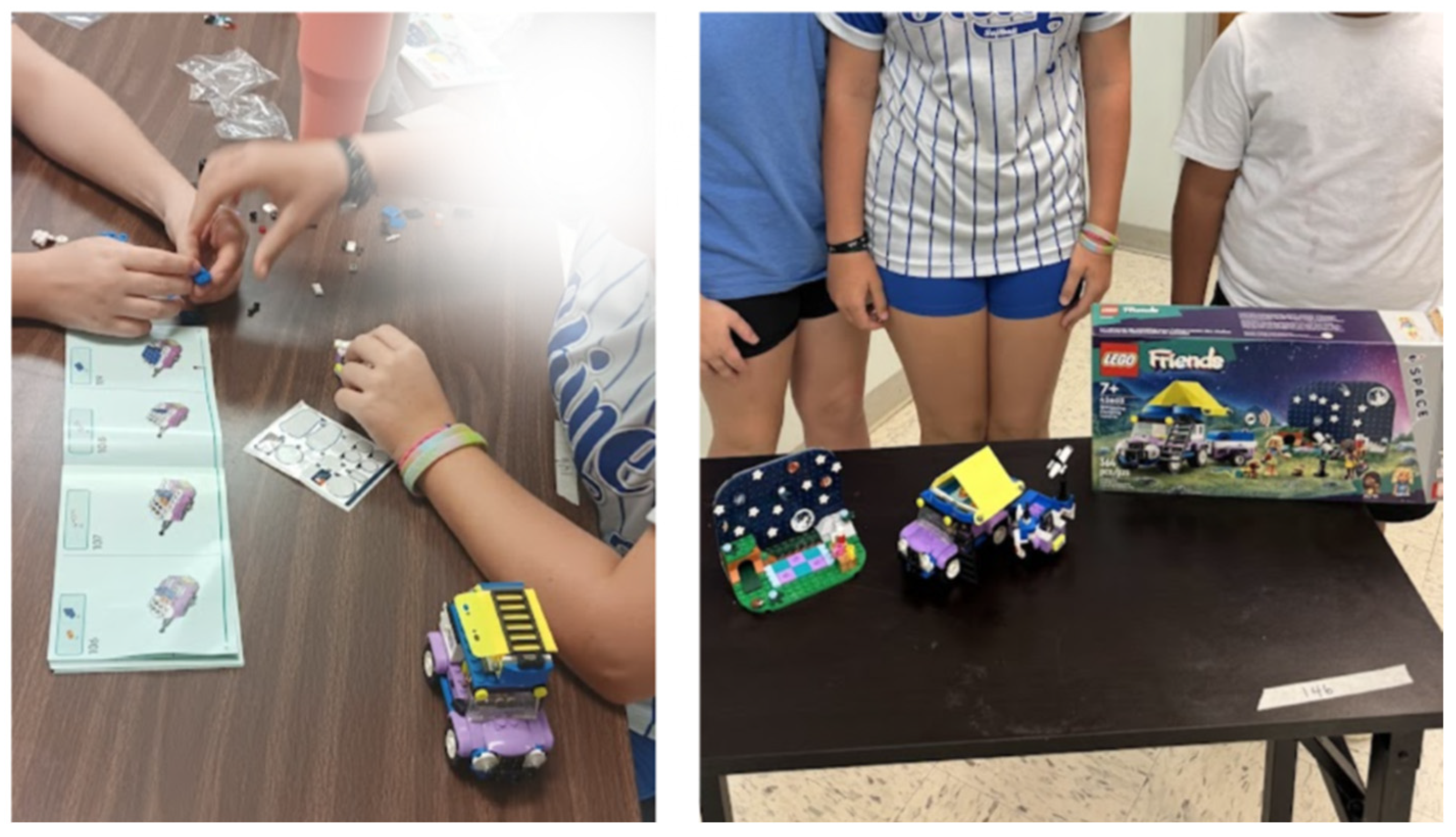The Influence of Unplugged LEGO Activities on Middle Grades Students’ Computational Thinking Dispositions in a STEM Camp
Abstract
:1. Introduction
1.1. Theoretical Framework: Computational Thinking Dispositions
1.1.1. Tolerance for Ambiguity
1.1.2. Persistence on Difficult Problems
1.1.3. Collaboration with Others to Achieve a Common Goal
1.2. Related Research Literature
1.2.1. Research on Computational Thinking Dispositions
1.2.2. Research on LEGOs in K-12 STEM Camps
2. Materials and Methods
2.1. Research Design
2.2. Research Context
2.3. Participants
2.4. Data Collection and Analysis
3. Results
3.1. Tolerance for Ambiguity
3.1.1. Structured Activities
3.1.2. Semi-Structured Activities
3.2. Persistence on Difficult Problems
3.2.1. Structured Activities
3.2.2. Semi-Structured Activities
3.3. Collaboration with Others to Achieve a Common Goal
3.3.1. Structured Activities
3.3.2. Semi-Structured Activities
4. Discussion
4.1. Reflection on Findings and Implications
4.2. Limitations
4.3. Suggestions for Further Research
Funding
Institutional Review Board Statement
Informed Consent Statement
Data Availability Statement
Conflicts of Interest
References
- Aslam, D. M., Abu-Ageel, A., Alfatlawi, M., Varney, M. W., Thompson, C. M., & Aslam, S. K. (2014). Passive maple-seed robotic fliers for education, research and entrepreneurship. Journal of Education and Training Studies, 2(2), 206–216. [Google Scholar] [CrossRef]
- Aslam, D. M., & Wise, K. D. (2003, June 4). Micro and nano technologies in K-12. Sensors Expo Conference, Session Keynote, Chicago, IL, USA. [Google Scholar]
- Bell, T. C., Witten, I. H., & Fellows, M. (1998). Computer science unplugged: Off-line activities and games for all ages. Computer Science Unplugged. Available online: https://classic.csunplugged.org/documents/books/english/unplugged-book-v1.pdf (accessed on 13 January 2023).
- Brennan, K., & Resnick, M. (2012, April 13–17). New frameworks for studying and assessing the development of computational thinking. 2012 Annual Meeting of the American Educational Research Association (pp. 1–25), Vancouver, BC, Canada. [Google Scholar]
- Brosnan, M. J. (1998). Spatial ability in children’s play with Lego blocks. Perceptual and Motor Skills, 87(1), 19–28. [Google Scholar] [CrossRef]
- Buitrago Flórez, F., Casallas, R., Hernández, M., Reyes, A., Restrepo, S., & Danies, G. (2017). Changing a generation’s way of thinking: Teaching computational thinking through programming. Review of Educational Research, 87(4), 834–860. [Google Scholar] [CrossRef]
- Casey, B. (2012). Preparing for the jobs of the future. Available online: https://www.jec.senate.gov/public/_cache/files/6aaa7e1f-9586-47be-82e7-326f47658320/stem-education---preparing-for-the-jobs-of-the-future-.pdf (accessed on 13 January 2023).
- Chiang, F. K., Zhang, Y., Zhu, D., Shang, X., & Jiang, Z. (2022). The influence of online STEM education camps on students’ self-efficacy, computational thinking, and task value. Journal of Science Education and Technology, 31(4), 461–472. [Google Scholar] [CrossRef]
- Chung, C. C. J., Cartwright, C., & Chung, C. (2014, March 8). Robot music camp 2013: An experiment to promote STEM and computer science. 2014 IEEE Integrated STEM Education Conference (pp. 1–7), Princeton, NJ, USA. [Google Scholar]
- Coe, R., Waring, M., Hedges, L. V., & Ashley, L. D. (Eds.). (2021). Research methods and methodologies in education. Sage. [Google Scholar]
- Cohen, J., & Berlin, R. (2020). What constitutes an “opportunity to learn” in teacher preparation? Journal of Teacher Education, 71(4), 434–448. [Google Scholar] [CrossRef]
- Dawson, C. (2019). Tackling limited spatial ability: Lowering one barrier into STEM? European Journal of Science and Mathematics Education, 7(1), 14–31. [Google Scholar] [CrossRef] [PubMed]
- Faber, H., Wierdsma, M., Doornbos, R. P., van der Ven, J. S., & de Vette, K. (2017). Teaching computational thinking to primary school students via unplugged programming lessons. Journal of the European Teacher Education Network, 12, 13–24. [Google Scholar]
- Hadad, R. (2024). The use of makerspaces for the development of computational thinking skills and dispositions: Pedagogical practices facilitators use. Computer Science Education, 1–40. [Google Scholar] [CrossRef]
- Hava, K., & Koyunlu Ünlü, Z. (2021). Investigation of the relationship between middle school students’ computational thinking skills and their STEM career interest and attitudes toward inquiry. Journal of Science Education and Technology, 30(4), 484–495. [Google Scholar] [CrossRef]
- Henningsen, M., & Stein, M. K. (1997). Mathematical tasks and student cognition: Classroom-based factors that support and inhibit high-level mathematical thinking and reasoning. Journal for Research in Mathematics Education, 28(5), 524–549. [Google Scholar] [CrossRef]
- Hixon, R. (2007). Teaching software engineering principles using Robolab and Lego Mindstorms. The International Journal of Engineering Education, 23(5), 868–873. [Google Scholar]
- Hsieh, H. F., & Shannon, S. E. (2005). Three approaches to qualitative content analysis. Qualitative Health Research, 15(9), 1277–1288. [Google Scholar] [CrossRef]
- International Society for Technology in Education & The Computer Science Teachers Association. (2011). Operational definition of computational thinking for K–12 education. Available online: https://cdn.iste.org/www-root/Computational_Thinking_Operational_Definition_ISTE.pdf (accessed on 10 February 2024).
- Jong, M. S.-Y., Geng, J., Chai, C. S., & Lin, P.-Y. (2020). Development and predictive validity of the computational thinking disposition questionnaire. Sustainability, 12, 4459. [Google Scholar] [CrossRef]
- Kovács, Z. (2020). Teaching algebraic curves for gifted learners at age 11 by using LEGO Linkages and GeoGebra. International Journal for Technology in Mathematics Education, 27(4), 207–217. [Google Scholar] [CrossRef]
- Leonard, J., Buss, A., Unertl, A., & Mitchell, M. (2016). Using robotics and game design to promote pathways to STEM (pp. 1488–1494). North American Chapter of the International Group for the Psychology of Mathematics Education. [Google Scholar]
- Looi, C. K., Chan, S. W., Wu, L., Huang, W., Kim, M. S., & Sun, D. (2024). Exploring computational thinking in the context of mathematics learning in secondary schools: Dispositions, engagement and learning performance. International Journal of Science and Mathematics Education, 22(5), 993–1011. [Google Scholar] [CrossRef]
- Manabe, H., Kanemune, S., Namiki, M., & Nakano, Y. (2011). CS unplugged assisted by digital materials for handicapped people at schools. In Informatics in schools. Contributing to 21st century education: 5th international conference on informatics in schools: Situation, evolution and perspectives, ISSEP 2011, Bratislava, Slovakia, proceedings 5 (pp. 82–93). Springer. [Google Scholar]
- Miles, M. B., Huberman, M., & Saldana, J. (2014). Qualitative data analysis: An expanded sourcebook. Sage Publications. [Google Scholar]
- Moore, H. E., & Rutherfurd, I. D. (2020). Researching agricultural environmental behaviour: Improving the reliability of self-reporting. Journal of Rural Studies, 76, 296–304. [Google Scholar] [CrossRef]
- Munasinghe, B., Bell, T., & Robins, A. (2023). Unplugged activities as a catalyst when teaching introductory programming. Journal of Pedagogical Research, 7(2), 56–71. [Google Scholar] [CrossRef]
- Pérez, A. (2018). A framework for computational thinking dispositions in mathematics education. Journal for Research in Mathematics Education, 49(4), 424–461. [Google Scholar] [CrossRef]
- Pratidhina, E., Adam, P., Kuswanto, H., & Rahmat, A. D. (2023). Investigation of science process skills and computational thinking dispositions during the implementation of collaborative modeling-based learning in high school physics class. Journal of Education and e-Learning Research, 10(4), 753–760. [Google Scholar]
- Roberts, J., & Eady, S. (2012). Enhancing the quality of learning: What are the benefits of a mixed age, collaborative approach to creative narrative writing? Education 3–13, 40(2), 205–216. [Google Scholar] [CrossRef]
- Taylor, K. V. (2020). Building school community through cross-grade collaborations in art. International Journal of Education Through Art, 16(3), 351–370. [Google Scholar] [CrossRef]
- Tuluri, F. (2015, March 7). Using robotics educational module as an interactive STEM learning platform. 2015 IEEE Integrated STEM Education Conference (pp. 16–20), Princeton, NJ, USA. [Google Scholar]
- Unnikrishnan, R., Amrita, N., Muir, A., & Rao, B. (2016, June 21–24). Of elephants and nested loops: How to introduce computing to youth in rural India. 15th International Conference on Interaction Design and Children (pp. 137–146), Manchester, UK. [Google Scholar]
- Üçgül, M., & Altıok, S. (2021). You are an astroneer: The effects of robotics camps on secondary school students’ perceptions and attitudes towards STEM. International Journal of Technology and Design Education, 32(3), 1679–1699. [Google Scholar] [CrossRef]
- Varney, M. W., Janoudi, A., Aslam, D. M., & Graham, D. (2011). Building young engineers: TASEM for third graders in Woodcreek Magnet Elementary School. IEEE Transactions on Education, 55(1), 78–82. [Google Scholar] [CrossRef]
- Wai, J., Lubinski, D., & Benbow, C. P. (2009). Spatial ability for STEM domains: Aligning over 50 years of cumulative psychological knowledge solidifies its importance. Journal of Educational Psychology, 101(4), 817. [Google Scholar] [CrossRef]
- Weller, D. P., Bott, T. E., Caballero, M. D., & Irving, P. W. (2022). Development and illustration of a framework for computational thinking practices in introductory physics. Physical Review Physics Education Research, 18(2), 020106. [Google Scholar] [CrossRef]
- Williams, D. C., Ma, Y., Prejean, L., Ford, M. J., & Lai, G. (2007). Acquisition of physics content knowledge and scientific inquiry skills in a robotics summer camp. Journal of Research on Technology in Education, 40(2), 201–216. [Google Scholar] [CrossRef]
- Wing, J. M. (2006). Computational thinking. Communications of the ACM, 49(3), 33–35. [Google Scholar] [CrossRef]
- Yadav, A., Good, J., Voogt, J., & Fisser, P. (2017). Computational thinking as an emerging competence domain. In Competence-based vocational and professional education: Bridging the worlds of work and education (pp. 1051–1067). Springer. [Google Scholar]
- Yin, R. K. (2014). Case study research. Thousand Oaks. [Google Scholar]
- Yin, Y., Hadad, R., Tang, X., & Lin, Q. (2019). Improving and assessing computational thinking in maker activities: The integration with physics and engineering learning. Journal of Science Education and Technology, 29, 189–214. [Google Scholar] [CrossRef]




| Day | Focus of the Day | Duration | Participation Structure |
|---|---|---|---|
| Monday | Semi-structured LEGO Activities | 3 h | Groups of 3–4 |
| Tuesday | Structured STEM Kits | 3 h | Groups of 3–4 |
| Wednesday | Structured STEM Kids | 3 h | Groups of 3–4 |
| Thursday | Semi-structured LEGO Activities | 3 h | Groups of 3–4 |
| Friday | Field Trip to Legoland, specifically LEGO city with the miniature structures and the rides | 6 h | Whole Group |
| Characteristic | Count (n) | Percent (%) |
|---|---|---|
| Gender | ||
| Female | 9 | 45 |
| Male | 11 | 55 |
| Race | ||
| Asian | 0 | 0 |
| American Indian/Alaskan Native | 0 | 0 |
| Black | 3 | 15 |
| Multiracial | 0 | 0 |
| Native Hawaiian or Other Pacific Islander | 0 | 0 |
| White | 17 | 85 |
| Ethnicity | ||
| Hispanic/Latinx | 6 | 30 |
| Non-Hispanic/Latinx | 14 | 70 |
| Upcoming Grade Level Completed | ||
| 4th | 8 | 40 |
| 5th | 4 | 20 |
| 6th | 3 | 15 |
| 7th | 4 | 20 |
| 8th | 1 | 5 |
| Computational Thinking Disposition | Rating |
|---|---|
| Tolerance for ambiguity | High tolerance for ambiguity |
| Developing tolerance for ambiguity | |
| Not Observed | |
| Persistence on difficult problems | High persistence |
| Developing persistence | |
| No evidence of persistence | |
| Collaboration with others to achieve a common goal | High willingness to collaborate with others |
| Developing willingness to collaborate with others | |
| Not observed |
Disclaimer/Publisher’s Note: The statements, opinions and data contained in all publications are solely those of the individual author(s) and contributor(s) and not of MDPI and/or the editor(s). MDPI and/or the editor(s) disclaim responsibility for any injury to people or property resulting from any ideas, methods, instructions or products referred to in the content. |
© 2025 by the author. Licensee MDPI, Basel, Switzerland. This article is an open access article distributed under the terms and conditions of the Creative Commons Attribution (CC BY) license (https://creativecommons.org/licenses/by/4.0/).
Share and Cite
Kudaisi, Q.J. The Influence of Unplugged LEGO Activities on Middle Grades Students’ Computational Thinking Dispositions in a STEM Camp. Educ. Sci. 2025, 15, 143. https://doi.org/10.3390/educsci15020143
Kudaisi QJ. The Influence of Unplugged LEGO Activities on Middle Grades Students’ Computational Thinking Dispositions in a STEM Camp. Education Sciences. 2025; 15(2):143. https://doi.org/10.3390/educsci15020143
Chicago/Turabian StyleKudaisi, Queshonda J. 2025. "The Influence of Unplugged LEGO Activities on Middle Grades Students’ Computational Thinking Dispositions in a STEM Camp" Education Sciences 15, no. 2: 143. https://doi.org/10.3390/educsci15020143
APA StyleKudaisi, Q. J. (2025). The Influence of Unplugged LEGO Activities on Middle Grades Students’ Computational Thinking Dispositions in a STEM Camp. Education Sciences, 15(2), 143. https://doi.org/10.3390/educsci15020143






